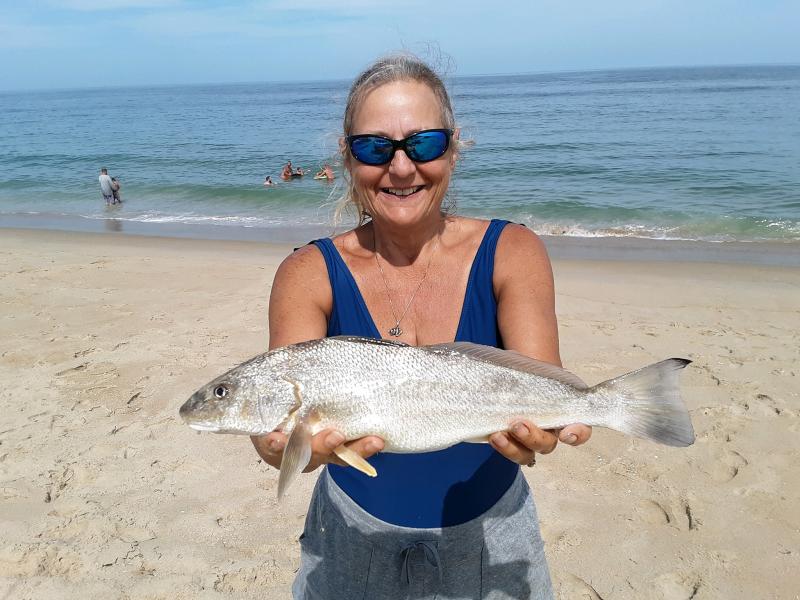My approach to catching cobia
There have been a good number of cobia caught this year, and most of them have been taken by sight casting. This is a fun way to fish, but it is not the only technique for catching cobia.
When I ran my charter service out of Virginia Beach in the 1990s, the two fish that made me the most money were cobia and striped bass. Stripers were my spring and fall fish, while cobia were my summer target.
When I first began fishing for cobia, I tried everything from sight casting to trolling to chumming. In the end, I found chumming the most cost-effective and productive method. I would run out and set up my chum slick in 20 feet of water along the edge of a shoal that ran west of the 12-Mile Marker on the Chesapeake Bay Bridge-Tunnel. Once I had the chum going, I set out three rods. One on the bottom baited with bunker, one halfway down, also with bunker, and one with no weight baited with a live eel. I also kept a heavy spinning rod ready to cast a bucktail with a bright-colored plastic tail should a cobia show up on the surface close to the boat. I am pretty sure this would work at Fenwick Shoal.
The downside to chumming is the unwanted attention your baits receive from sharks, rays and crabs. I did have a two-man party from Iowa who had never been on saltwater before. We didn’t catch a cobia, but spent the morning pulling in one cow-nosed ray after another. They were thrilled. Kept taking photos and couldn’t wait to get back to the dock and show their girlfriends.
Trolling is another method to catch cobia. You can pull spoons and plugs that cobia will strike, as will king mackerel, false albacore and bonito.
I usually troll with four lines. I run flat lines off the transom with spoons on planers or deep-diving plugs. From the outriggers, I run a 4-1/2-Drone spoon on a 30-foot leader of 40- or 50-pound mono connected to a two- or three-ounce torpedo sinker with a black ball bearing Coast-Loc snap-swivel. If I know there are Spanish mackerel or bonito in the area, I may run a 0 Drone spoon from one outrigger, but if there are small blues around, the small spoon stays in the boat.
Trawl survey
I attended an Aug. 13 seminar sponsored by Prime Hook National Wildlife Refuge held at the CHEER Center in Milton where Mike Greco gave an excellent presentation on the trawl survey conducted every year in Delaware Bay, Indian River Bay and Rehoboth Bay.
The surveys have been going on for a long time, and have documented the rise and fall of several species important to recreational anglers.
The one fish that everyone associates with Delaware Bay is the sea trout or weakfish. The trawl surveys showed an abundance between 1966 and 1971, then a decrease from 1979 to 1984. There was another increase from 1983 to 2002. The problem is while they see trout up to 3 years old in their nets, they seldom catch anything older than that. What happens to the 3-year-old weakfish once they leave Delaware Bay? There are several theories, but in truth, no one knows.
Summer flounder have been on a steady decline since 2002. The years 2017 and 2018 did see more flounder, but it will take a few years for these fish to reach keeper size.
Striped bass followed the Young-of -the-Year Index from Chesapeake Bay very closely. There has been an uptick since 2014, but once again it will take time for these fish to enter the coastal migration.
As you might guess, the trawl picks up all sorts of sea creatures including sharks, rays, sturgeon, horseshoe crabs, blue crabs, eels, spot, croaker, kings and squid. Everything is measured and logged on the catch report. Compiling these reports over many years allows fishery managers to gauge the health of the stocks that we depend on for our fishing.
Fishing report
Flounder fishing in the ocean continues to be good. Charter boats have been bringing in limits of flatfish, and some private boats do equally well. Experienced head boat patrons also box their four flounder on most trips. Jigging with Gulp! or working a live spot have accounted for most of the flounder.
The Delaware Bay reef sites have also produced a few nice flounder. Live spot or jigs with Gulp! have worked here as well. More common catches on the reef sites have been spot, kings, croaker and blowfish. A few keeper trout have also been taken. Bloodworms, FishBite bloodworms, squid strips, clams and Gulp! work on these fish.


























































